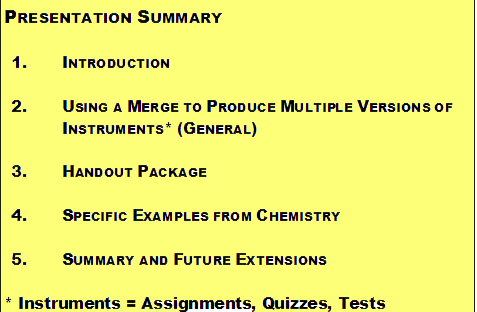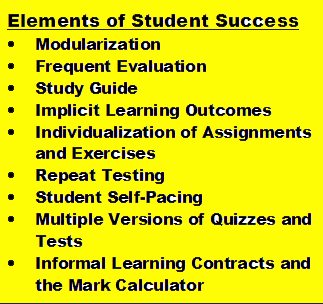
Elements of Student Success
|
Promoting Student Success
Published In-House, Mohawk College, October 2005.
This eight-page article lists and describes the nine elements (see to the left) employed in my teaching methodology. The article explains why, when, and how these techniques were used.
This article may be downloaded as a pdf file (39 kB):
Download
|
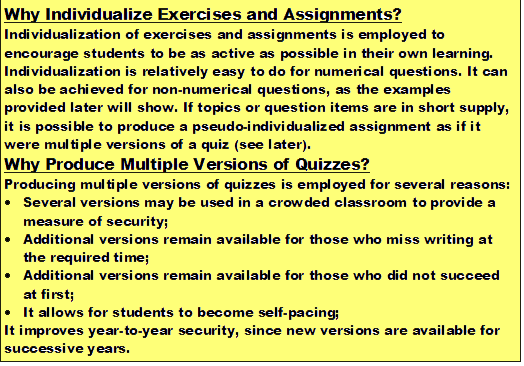
Why Individualize and Produce Multiple Versions?
|
Methods For Individualizing Instruction
Published In-House, Mohawk College, October 2005.
This seven-page article explains why, and lists and describes the methods used to individualize exercises, such as pre- and post-laboratory questions, and assignments. The article also explains why, and how, multiple versions of quizzes and matching exercises were produced.
This article may be downloaded as a pdf file (44 kB):
Download
|
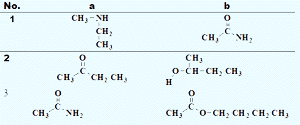
Part of a Table-Format Data Base
for an Organic Functional Groups Matching Exercise
|
Multiple Versions of Matching Exercises by Merge Operation of a Word Processor
CRUCIBLE, Vol. 36, No. 2, November 2004, pages 11-13.
The article describes how to create multiple versions of a matching exercise using a standard mail merge procedure of a word processor application.
Either or both of the questions and the answers may be "scrambled" in the data base to create multiple versions when merged. The data base may be in a table format, or in a spreadsheet.
Part 1 (pages 1-20) of the issue containing this article may be downloaded BY STAO MEMBERS ONLY from the CRUCIBLE archive as a pdf file (664 kB):
Download
Navigate to Example 3 below which is an example of this type of individualization. click here
You can be sent examples of the files required for generating multiple versions of matching exercises by return email.
|
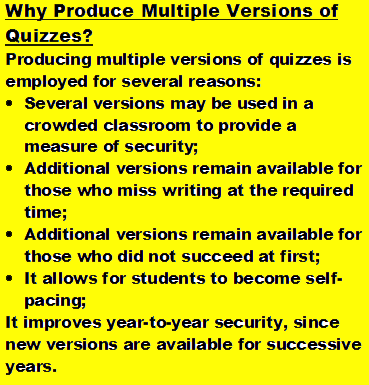
Why Produce Multiple Versions of Quizzes?
|
Making multiple versions of an organic chemistry naming quiz using a mail merge operation
CHEM 13 NEWS, October, 2003,
Number 314, pages 8-9.
The mail merge operation of a standard word processor application can be used to produce multiple versions of quizzes (or assignments). The article describes how this can be done to produce an organic chemistry naming quiz in multiple versions.
A spreadsheet can be used as the data base for text items, while a Word for Windows table can be used as the data base for either text or graphic items, such as ChemDraw chemical structures.
Navigate to Example 4 below which is an example of this type of individualization. click here
You can be sent examples of the files required for generating multiple versions of naming quizzes by return email.
|
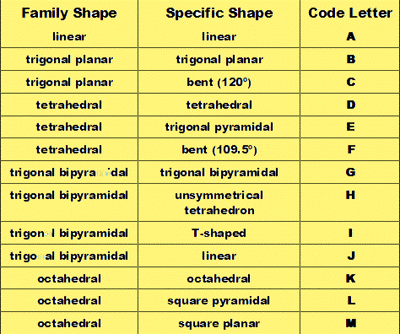
Answer Code Table for the VSEPR Assignment
|
A pseudo-individualized assignment for VSEPR theory
CHEM 13 NEWS, December, 2000, Number 289, pages 4-6.
The article describes the use of a mail merge operation to produce individualized VSEPR theory assignments for a large number of students.
The 34 molecules and polyatomic ions used for the assignment range range from the linear family to the octahedral family. All are real substances, culled from the pages of "Chemistry of the Elements", by Greenwood and Earnshaw.
You can be sent examples of the files required for generating this individualized assignment by return email.
|
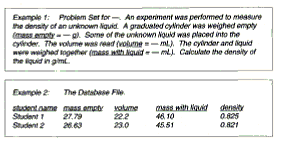
Individualized Assignments by Mail Merge
|
Individualized Assignments by Mail Merge
CRUCIBLE, Vol. 25, No. 1, March 1994, pages 24-25.
The article describes how to create calculation assignments (or exercises) with individualized randomly generated numbers using a spreadsheet and a mail merge procedure of a word processor application.
The issue containing this article may be downloaded BY STAO MEMBERS ONLY from the CRUCIBLE archive as a pdf file
(10.3 MB):
Download
|
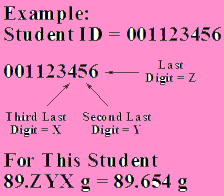
Individualizing Numbers Using a Student ID
|
Example 1
Individualized Numbers for Calculations: A Simple Example
Example 1 is a simple example of an individualized numerical calculation. This pre-laboratory question is extracted from a general chemistry laboratory manual. The method by which the student generates his/her individualized numbers is described.
The text of Example 1 may be downloaded as a Word for Windows file
(46 kB):
Download
There is a calculation spreadsheet which generates of all of the student answers for marking.
The answer calculation spreadsheet for Example 1 may be downloaded as an Excel for Windows file (15 kB):
Download
|
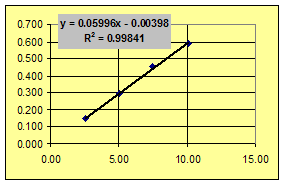
A Calibration Plot From Individualized Data Points
|
Example 2
Individualized Numbers for Calculations: A Complex Example
- Plotting a Calibration Curve
Example 2 is a complex example of an individualized plotting exercise with associated calculations. This pre-laboratory question is extracted from a general chemistry laboratory manual.
The text of Example 2 may be downloaded as a Word for Windows file
(37 kB):
Download
There is a calculation spreadsheet which generates of all of the student answers for marking.
The answer calculation spreadsheet for Example 2 may be downloaded as an Excel for Windows file (22 kB):
Download
|
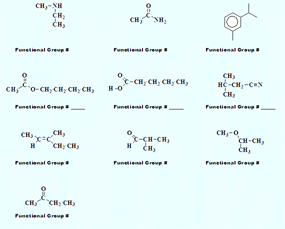
An Organic Matching Quiz
|
Example 3
A Set of 20 Multiple Versions of an Organic Matching Quiz
Example 3 is a set of 20 multiple versions of an organic chemistry matching quiz. This quiz is extracted from an introductory organic chemistry course.
The method by which these multiple versions were generated is described in detail in the first published article described in Section 2 above, and in the conference handout described in Section 3 above.
Example 3 may be downloaded as a Word for Windows file (602 kB):
Download
|
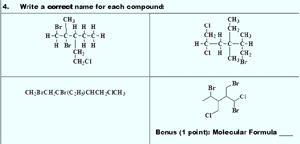
Part of an Organic Naming Quiz
|
Example 4
A Set of 20 Multiple Versions of an Organic Naming Quiz
Example 4 is a set of 20 multiple versions of an organic chemistry naming quiz. This quiz is extracted from an introductory organic chemistry course.
The method by which these multiple versions were generated is described in detail in the second published article described in Section 2 above, and in the conference handout described in Section 3 above.
Example 4 may be downloaded as a Word for Windows file (623 kB):
Download
|
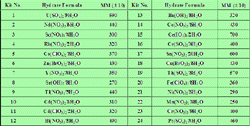
Table of Hydrate Formulas
|
Example 5
A Set of 24 Hydrated Salt Formulas for a Molar Mass Calculation
Example 5 is an individualized formula mass calculation based on a set of 24 formulas of inorganic hydrate salts.
The question and the table are extracted from an introductory general chemistry laboratory manual.
All of the salts in the table are real substances, listed in the CRC Handbook.
Example 5 may be downloaded as a Word for Windows file (90 kB):
Download
|

Organic Synthesis of an Azo Dye
|
Example 6
An Individualized Pre-Laboratory Question Using a Double-Table
Example 6 is an individualized set of pre-laboratory questions based on a double-table of organic chemical reagents.
The double table method (the example is a 10 x 10 pair) allows the generation of many combinations (in this case 100) from a small set of items.
The questions and the tables of this example are extracted from an upper-level organic chemistry laboratory manual.
Example 6 may be downloaded as a Word for Windows file (99 kB):
Download
|







